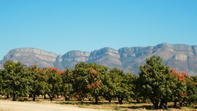Mangoes are an alternate bearing crop, that can deliver a large harvest one year, reducing its yield by about 25% the next year.

Trees take about three to four years to start bearing fruit and depending on the region it can take eight years.
This is particularly true for the Hoedspruit area in the Limpopo Province, while in Clanwilliam it can take up to 12 years to grow to an adult and full production capacity.
Climate for Mangoes
Mango trees can tolerate a wide range of climatic conditions - from hot and humid to cool and dry climates. Therefore, it can be grown over a wide area in South Africa. The temperature which mangoes can be successfully grown under range from 5°C to 45°C, but optimal day temperatures should be between 27°C to 36°C.
Mangoes can tolerate humidity as well as dry air conditions but humidity should ideally be below 55% from October until fruit is harvested in the months from December to March.
Mangoes do best in areas which are dry during spring to early summer as the flowers and developing fruit are very sensitive to fungal diseases which develop under moist conditions.
Select wind-protected areas or plant windbreaks near mango orchards. Wind causes chafing and scratch marks and can cause fruit drop. Skin perforations due to wind damage can lead to fungal and bacterial infections. Prevent wind damage by planting windbreaks and orienting orchards diagonally to the dominant wind direction.
Planting Mangoes
Choose strong plants from reputable nurseries. Inspect the leaves and flowers, internodes, graft unions as well as the soil mixture and the tree’s root system.
A thorough soil analysis prior to planting will indicate which nutrients are deficient or in excess. This can be adjusted during soil preparation prior to planting and again during the growing season according to foliar analysis.
Mangoes should be planted at the end of the cold and rainy season - August to September are best. Planting distance depends on the growth of the cultivar and can range from 12 x 12 m apart to 2.5 x 2.5 m in high-density mango orchards.
After planting, mangoes develop a strong taproot that can extend to 6 m deep.
Mango trees grow and produce well on various soil types but a sandy loam or loam (with a clay content of 15 to 25%) is ideal. Soil with compacted layers should be avoided as well as soil that can lead to waterlogged conditions. A pH of 6 - 7.2 is optimal.
Management Practices for Mangoes
Depending on the intensity of farming, cultivar and management style, management practices include actions such as fertilisation, irrigation, pruning, crop protection and more. A few aspects are noted below. More detailed advice can be found by joining technical study groups and from agricultural advisors.
Mango trees flower at an estimation of 28 days. Although mango trees are self-pollinating and cross-pollinated by wind or insects, the Agricultural Research Council (ARC) recommends bee pollination of mango trees at 3 to 15 hives/ha.
Mango trees are pruned after harvest and all panicles (short ‘branches’ which hold the mangoes) are cut off. Pruning to ‘open up’ trees for proper penetration of sunlight into the middle of the tree and removes old wood to encourage new growth.
Fertilisation, depending on soil and leaf analyses, is usually done after harvest.
Protecting mangoes from diseases such as anthracnose and fruit flies are best done according to an integrated pest management program. Chemicals used in mango production must be registered and it is important to adhere to protocols related to crop spray residues and market restrictions.
Although mango trees are drought-tolerant, irrigation improves fruit yield and fruit size. The type of irrigation and irrigation program is dependent on factors such as soil type, management style and climate, and is best discussed with an irrigation expert. Both micro and drip irrigation is used in South Africa.
Pests and Diseases of Mangoes
Anthracnose is a common post-harvest fungal disease which affects all mango cultivars and can be seen as brown-black spots on the leaves. Mangoes will be less affected in warm areas where it matures early and where it does not hang on the trees throughout the rainy season.
Bacterial black spot is another rain-related disease and can be treated with copper-based sprays. It manifests as water-soaked lesions on the fruit. Powdery mildew is a fungal disease visible as white powdery patches on young shoots, leaves, flowers or fruit.
Pests of mangoes include the fruit fly, mango weevil and tip wilter, a pest in young trees.
By Marinda Louw